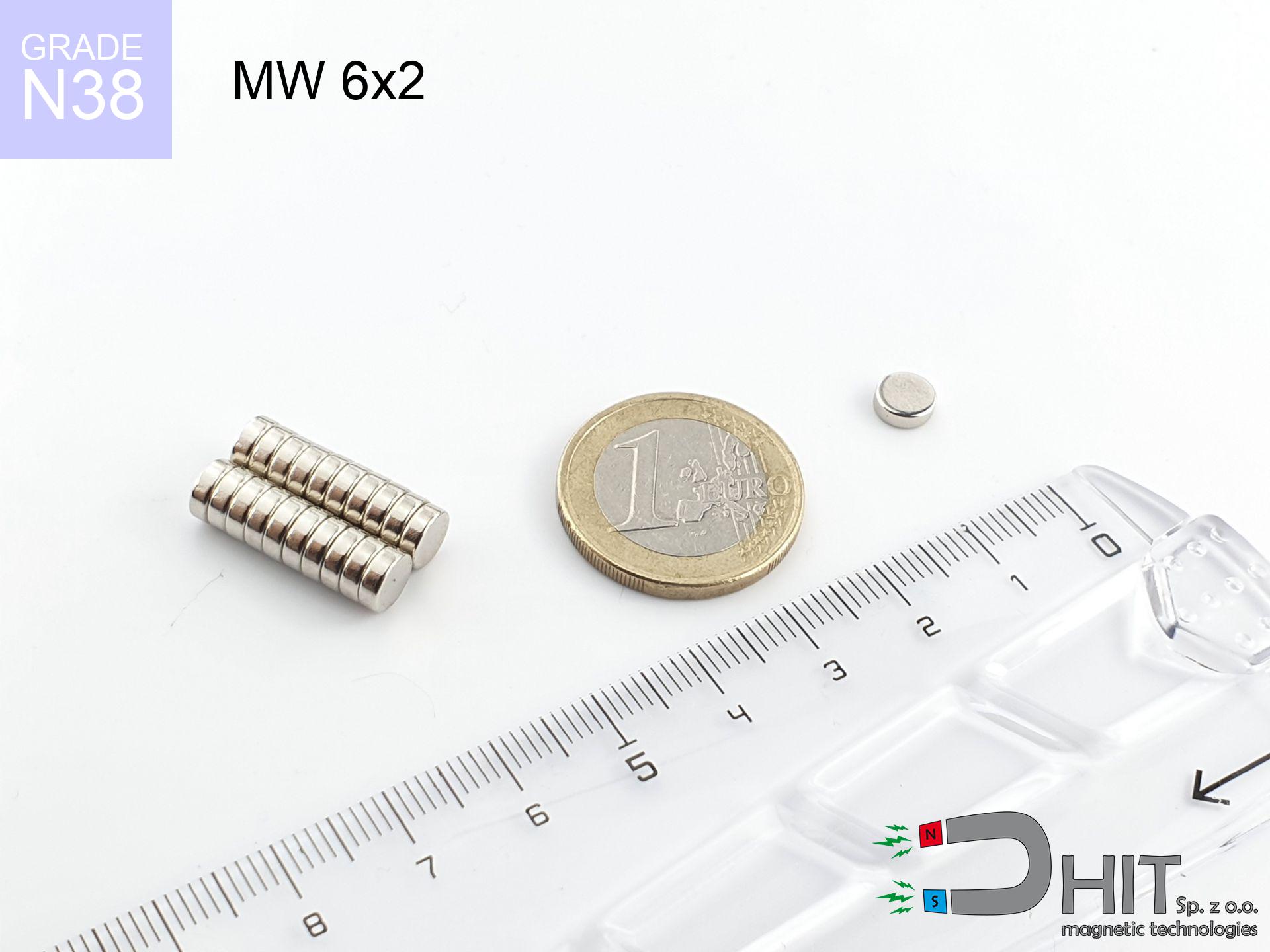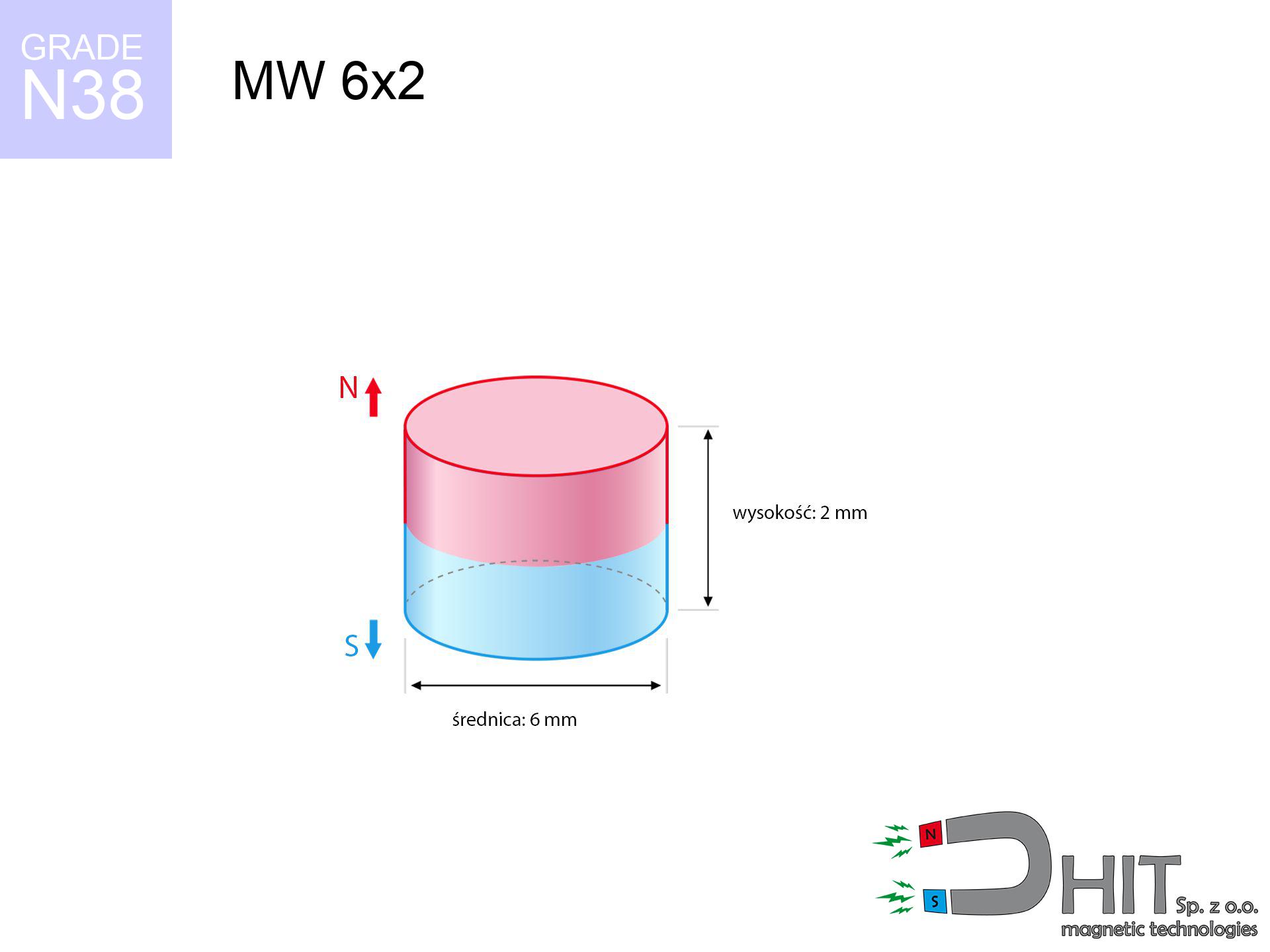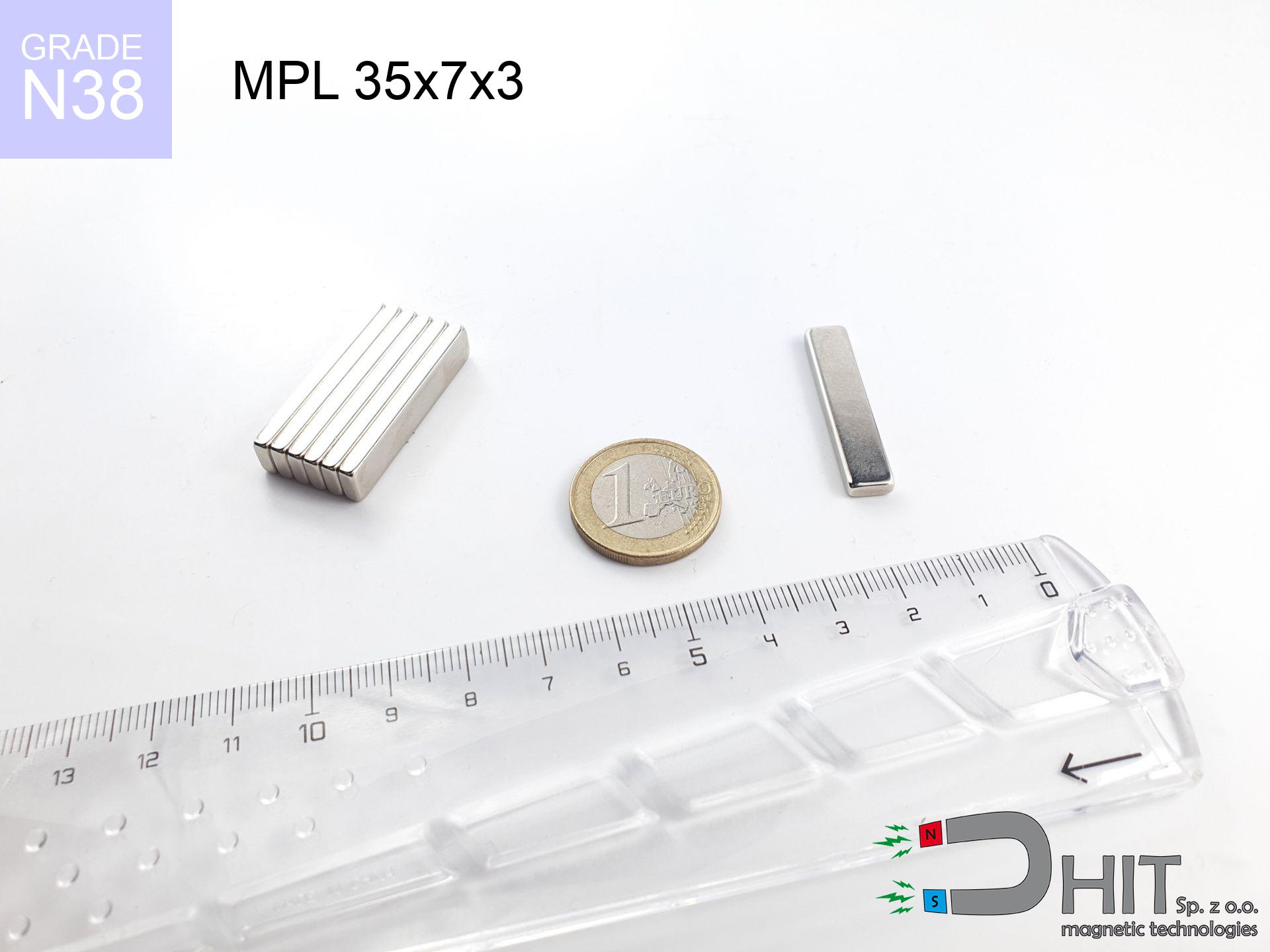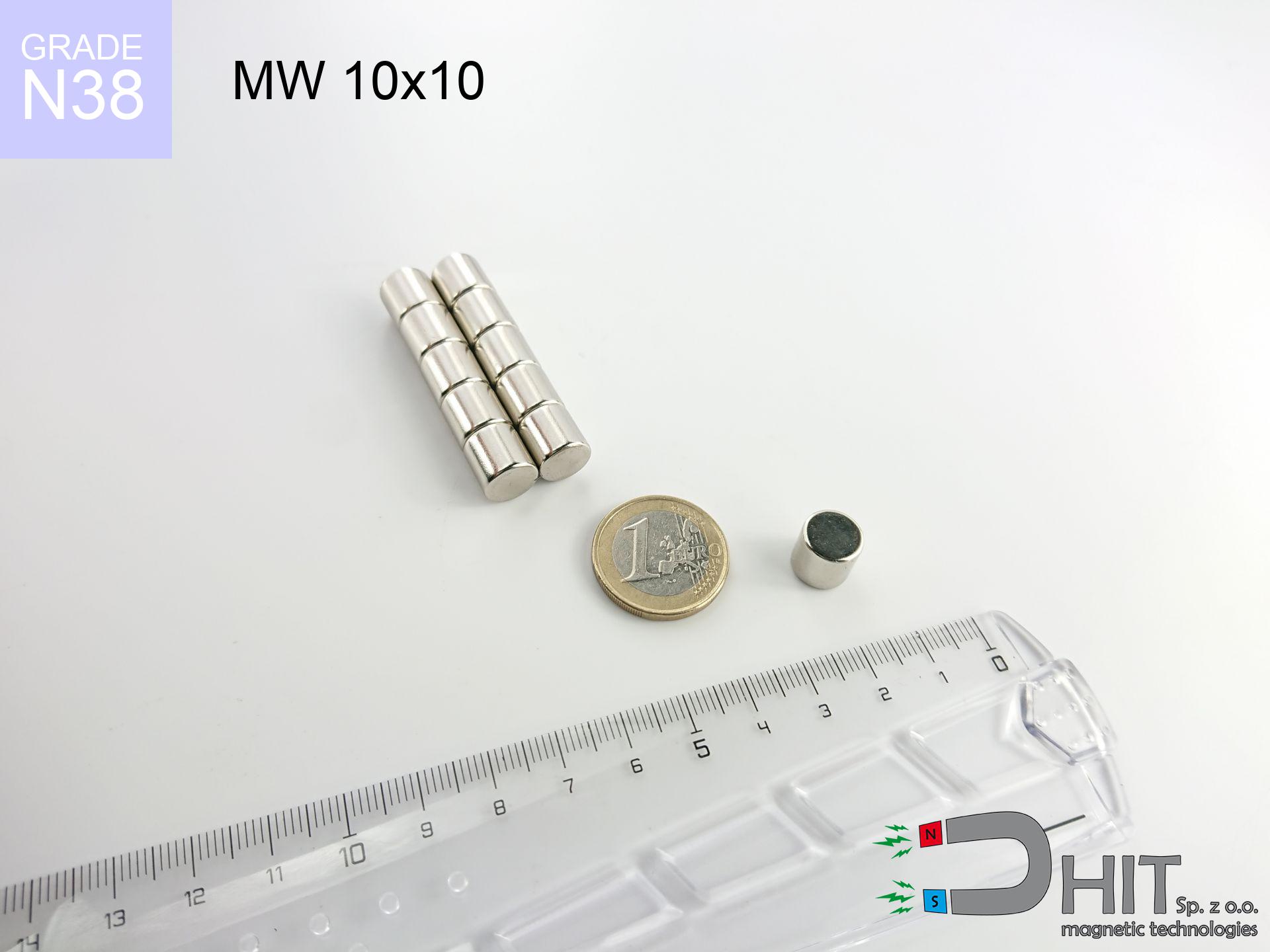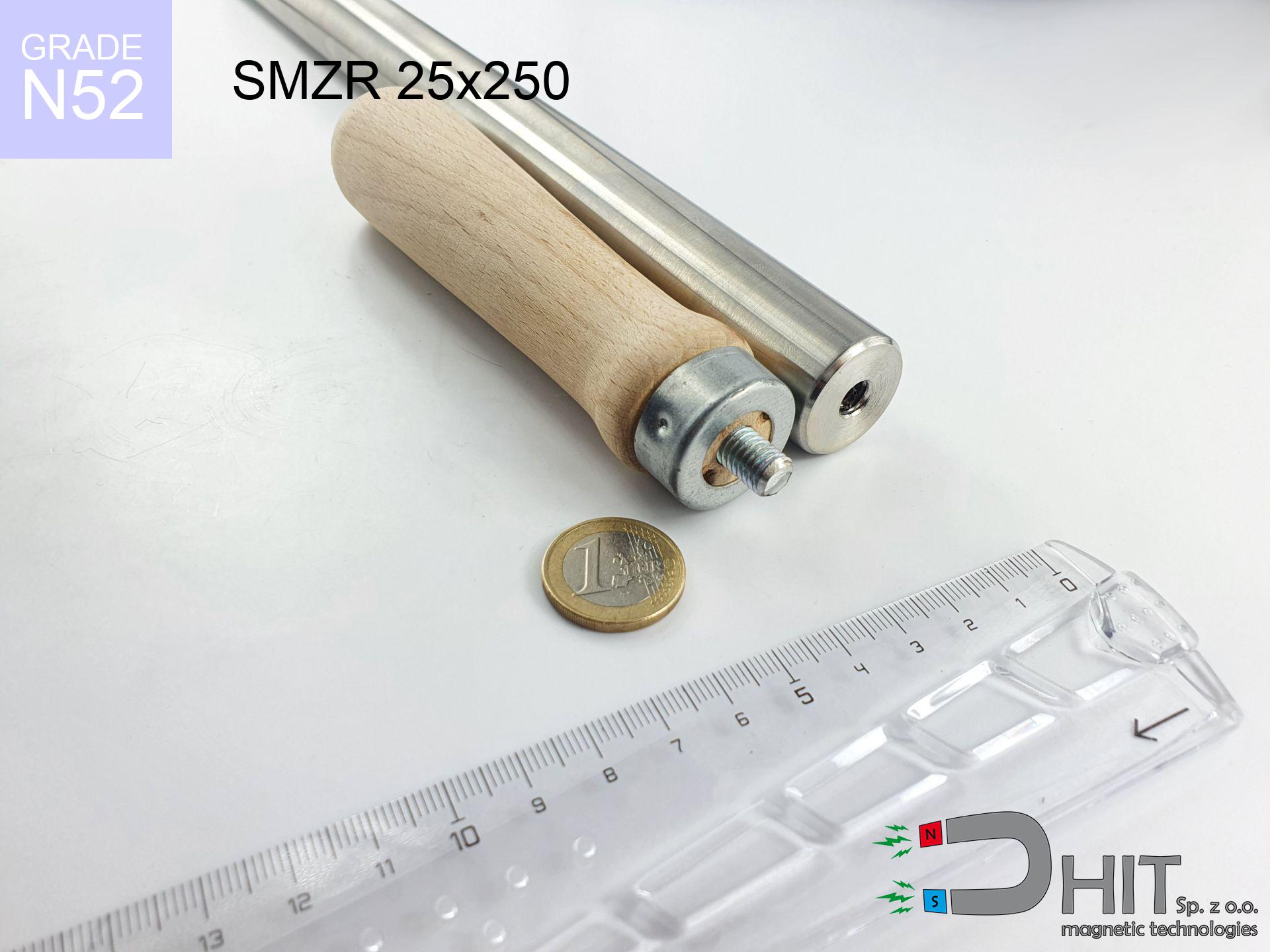MW 6x2 / N38 - cylindrical magnet
cylindrical magnet
Catalog no 010092
GTIN/EAN: 5906301810919
Diameter Ø
6 mm [±0,1 mm]
Height
2 mm [±0,1 mm]
Weight
0.42 g
Magnetization Direction
↑ axial
Load capacity
0.86 kg / 8.43 N
Magnetic Induction
343.37 mT / 3434 Gs
Coating
[NiCuNi] Nickel
0.246 ZŁ with VAT / pcs + price for transport
0.200 ZŁ net + 23% VAT / pcs
bulk discounts:
Need more?
Call us
+48 888 99 98 98
otherwise get in touch via
contact form
the contact form page.
Parameters as well as structure of neodymium magnets can be reviewed with our
force calculator.
Orders placed before 14:00 will be shipped the same business day.
Technical specification of the product - MW 6x2 / N38 - cylindrical magnet
Specification / characteristics - MW 6x2 / N38 - cylindrical magnet
| properties | values |
|---|---|
| Cat. no. | 010092 |
| GTIN/EAN | 5906301810919 |
| Production/Distribution | Dhit sp. z o.o. |
| Country of origin | Poland / China / Germany |
| Customs code | 85059029 |
| Diameter Ø | 6 mm [±0,1 mm] |
| Height | 2 mm [±0,1 mm] |
| Weight | 0.42 g |
| Magnetization Direction | ↑ axial |
| Load capacity ~ ? | 0.86 kg / 8.43 N |
| Magnetic Induction ~ ? | 343.37 mT / 3434 Gs |
| Coating | [NiCuNi] Nickel |
| Manufacturing Tolerance | ±0.1 mm |
Magnetic properties of material N38
| properties | values | units |
|---|---|---|
| remenance Br [min. - max.] ? | 12.2-12.6 | kGs |
| remenance Br [min. - max.] ? | 1220-1260 | mT |
| coercivity bHc ? | 10.8-11.5 | kOe |
| coercivity bHc ? | 860-915 | kA/m |
| actual internal force iHc | ≥ 12 | kOe |
| actual internal force iHc | ≥ 955 | kA/m |
| energy density [min. - max.] ? | 36-38 | BH max MGOe |
| energy density [min. - max.] ? | 287-303 | BH max KJ/m |
| max. temperature ? | ≤ 80 | °C |
Physical properties of sintered neodymium magnets Nd2Fe14B at 20°C
| properties | values | units |
|---|---|---|
| Vickers hardness | ≥550 | Hv |
| Density | ≥7.4 | g/cm3 |
| Curie Temperature TC | 312 - 380 | °C |
| Curie Temperature TF | 593 - 716 | °F |
| Specific resistance | 150 | μΩ⋅cm |
| Bending strength | 250 | MPa |
| Compressive strength | 1000~1100 | MPa |
| Thermal expansion parallel (∥) to orientation (M) | (3-4) x 10-6 | °C-1 |
| Thermal expansion perpendicular (⊥) to orientation (M) | -(1-3) x 10-6 | °C-1 |
| Young's modulus | 1.7 x 104 | kg/mm² |
Physical analysis of the product - report
The following data are the outcome of a physical simulation. Values rely on algorithms for the class Nd2Fe14B. Real-world performance might slightly deviate from the simulation results. Please consider these data as a reference point for designers.
Table 1: Static force (force vs distance) - power drop
MW 6x2 / N38
| Distance (mm) | Induction (Gauss) / mT | Pull Force (kg/lbs/g/N) | Risk Status |
|---|---|---|---|
| 0 mm |
3430 Gs
343.0 mT
|
0.86 kg / 1.90 LBS
860.0 g / 8.4 N
|
low risk |
| 1 mm |
2423 Gs
242.3 mT
|
0.43 kg / 0.95 LBS
429.2 g / 4.2 N
|
low risk |
| 2 mm |
1521 Gs
152.1 mT
|
0.17 kg / 0.37 LBS
169.0 g / 1.7 N
|
low risk |
| 3 mm |
932 Gs
93.2 mT
|
0.06 kg / 0.14 LBS
63.5 g / 0.6 N
|
low risk |
| 5 mm |
382 Gs
38.2 mT
|
0.01 kg / 0.02 LBS
10.7 g / 0.1 N
|
low risk |
| 10 mm |
76 Gs
7.6 mT
|
0.00 kg / 0.00 LBS
0.4 g / 0.0 N
|
low risk |
| 15 mm |
26 Gs
2.6 mT
|
0.00 kg / 0.00 LBS
0.0 g / 0.0 N
|
low risk |
| 20 mm |
12 Gs
1.2 mT
|
0.00 kg / 0.00 LBS
0.0 g / 0.0 N
|
low risk |
| 30 mm |
4 Gs
0.4 mT
|
0.00 kg / 0.00 LBS
0.0 g / 0.0 N
|
low risk |
| 50 mm |
1 Gs
0.1 mT
|
0.00 kg / 0.00 LBS
0.0 g / 0.0 N
|
low risk |
Table 2: Sliding hold (vertical surface)
MW 6x2 / N38
| Distance (mm) | Friction coefficient | Pull Force (kg/lbs/g/N) |
|---|---|---|
| 0 mm | Stal (~0.2) |
0.17 kg / 0.38 LBS
172.0 g / 1.7 N
|
| 1 mm | Stal (~0.2) |
0.09 kg / 0.19 LBS
86.0 g / 0.8 N
|
| 2 mm | Stal (~0.2) |
0.03 kg / 0.07 LBS
34.0 g / 0.3 N
|
| 3 mm | Stal (~0.2) |
0.01 kg / 0.03 LBS
12.0 g / 0.1 N
|
| 5 mm | Stal (~0.2) |
0.00 kg / 0.00 LBS
2.0 g / 0.0 N
|
| 10 mm | Stal (~0.2) |
0.00 kg / 0.00 LBS
0.0 g / 0.0 N
|
| 15 mm | Stal (~0.2) |
0.00 kg / 0.00 LBS
0.0 g / 0.0 N
|
| 20 mm | Stal (~0.2) |
0.00 kg / 0.00 LBS
0.0 g / 0.0 N
|
| 30 mm | Stal (~0.2) |
0.00 kg / 0.00 LBS
0.0 g / 0.0 N
|
| 50 mm | Stal (~0.2) |
0.00 kg / 0.00 LBS
0.0 g / 0.0 N
|
Table 3: Vertical assembly (sliding) - behavior on slippery surfaces
MW 6x2 / N38
| Surface type | Friction coefficient / % Mocy | Max load (kg/lbs/g/N) |
|---|---|---|
| Raw steel |
µ = 0.3
30% Nominalnej Siły
|
0.26 kg / 0.57 LBS
258.0 g / 2.5 N
|
| Painted steel (standard) |
µ = 0.2
20% Nominalnej Siły
|
0.17 kg / 0.38 LBS
172.0 g / 1.7 N
|
| Oily/slippery steel |
µ = 0.1
10% Nominalnej Siły
|
0.09 kg / 0.19 LBS
86.0 g / 0.8 N
|
| Magnet with anti-slip rubber |
µ = 0.5
50% Nominalnej Siły
|
0.43 kg / 0.95 LBS
430.0 g / 4.2 N
|
Table 4: Material efficiency (saturation) - sheet metal selection
MW 6x2 / N38
| Steel thickness (mm) | % power | Real pull force (kg/lbs/g/N) |
|---|---|---|
| 0.5 mm |
|
0.09 kg / 0.19 LBS
86.0 g / 0.8 N
|
| 1 mm |
|
0.22 kg / 0.47 LBS
215.0 g / 2.1 N
|
| 2 mm |
|
0.43 kg / 0.95 LBS
430.0 g / 4.2 N
|
| 3 mm |
|
0.65 kg / 1.42 LBS
645.0 g / 6.3 N
|
| 5 mm |
|
0.86 kg / 1.90 LBS
860.0 g / 8.4 N
|
| 10 mm |
|
0.86 kg / 1.90 LBS
860.0 g / 8.4 N
|
| 11 mm |
|
0.86 kg / 1.90 LBS
860.0 g / 8.4 N
|
| 12 mm |
|
0.86 kg / 1.90 LBS
860.0 g / 8.4 N
|
Table 5: Thermal stability (stability) - thermal limit
MW 6x2 / N38
| Ambient temp. (°C) | Power loss | Remaining pull (kg/lbs/g/N) | Status |
|---|---|---|---|
| 20 °C | 0.0% |
0.86 kg / 1.90 LBS
860.0 g / 8.4 N
|
OK |
| 40 °C | -2.2% |
0.84 kg / 1.85 LBS
841.1 g / 8.3 N
|
OK |
| 60 °C | -4.4% |
0.82 kg / 1.81 LBS
822.2 g / 8.1 N
|
|
| 80 °C | -6.6% |
0.80 kg / 1.77 LBS
803.2 g / 7.9 N
|
|
| 100 °C | -28.8% |
0.61 kg / 1.35 LBS
612.3 g / 6.0 N
|
Table 6: Magnet-Magnet interaction (repulsion) - field range
MW 6x2 / N38
| Gap (mm) | Attraction (kg/lbs) (N-S) | Shear Force (kg/lbs/g/N) | Repulsion (kg/lbs) (N-N) |
|---|---|---|---|
| 0 mm |
2.05 kg / 4.52 LBS
4 944 Gs
|
0.31 kg / 0.68 LBS
308 g / 3.0 N
|
N/A |
| 1 mm |
1.52 kg / 3.34 LBS
5 900 Gs
|
0.23 kg / 0.50 LBS
228 g / 2.2 N
|
1.37 kg / 3.01 LBS
~0 Gs
|
| 2 mm |
1.02 kg / 2.26 LBS
4 847 Gs
|
0.15 kg / 0.34 LBS
154 g / 1.5 N
|
0.92 kg / 2.03 LBS
~0 Gs
|
| 3 mm |
0.65 kg / 1.44 LBS
3 869 Gs
|
0.10 kg / 0.22 LBS
98 g / 1.0 N
|
0.59 kg / 1.29 LBS
~0 Gs
|
| 5 mm |
0.25 kg / 0.54 LBS
2 379 Gs
|
0.04 kg / 0.08 LBS
37 g / 0.4 N
|
0.22 kg / 0.49 LBS
~0 Gs
|
| 10 mm |
0.03 kg / 0.06 LBS
764 Gs
|
0.00 kg / 0.01 LBS
4 g / 0.0 N
|
0.02 kg / 0.05 LBS
~0 Gs
|
| 20 mm |
0.00 kg / 0.00 LBS
153 Gs
|
0.00 kg / 0.00 LBS
0 g / 0.0 N
|
0.00 kg / 0.00 LBS
~0 Gs
|
| 50 mm |
0.00 kg / 0.00 LBS
12 Gs
|
0.00 kg / 0.00 LBS
0 g / 0.0 N
|
0.00 kg / 0.00 LBS
~0 Gs
|
| 60 mm |
0.00 kg / 0.00 LBS
7 Gs
|
0.00 kg / 0.00 LBS
0 g / 0.0 N
|
0.00 kg / 0.00 LBS
~0 Gs
|
| 70 mm |
0.00 kg / 0.00 LBS
5 Gs
|
0.00 kg / 0.00 LBS
0 g / 0.0 N
|
0.00 kg / 0.00 LBS
~0 Gs
|
| 80 mm |
0.00 kg / 0.00 LBS
3 Gs
|
0.00 kg / 0.00 LBS
0 g / 0.0 N
|
0.00 kg / 0.00 LBS
~0 Gs
|
| 90 mm |
0.00 kg / 0.00 LBS
2 Gs
|
0.00 kg / 0.00 LBS
0 g / 0.0 N
|
0.00 kg / 0.00 LBS
~0 Gs
|
| 100 mm |
0.00 kg / 0.00 LBS
2 Gs
|
0.00 kg / 0.00 LBS
0 g / 0.0 N
|
0.00 kg / 0.00 LBS
~0 Gs
|
Table 7: Safety (HSE) (electronics) - warnings
MW 6x2 / N38
| Object / Device | Limit (Gauss) / mT | Safe distance |
|---|---|---|
| Pacemaker | 5 Gs (0.5 mT) | 3.0 cm |
| Hearing aid | 10 Gs (1.0 mT) | 2.5 cm |
| Timepiece | 20 Gs (2.0 mT) | 2.0 cm |
| Phone / Smartphone | 40 Gs (4.0 mT) | 1.5 cm |
| Remote | 50 Gs (5.0 mT) | 1.5 cm |
| Payment card | 400 Gs (40.0 mT) | 0.5 cm |
| HDD hard drive | 600 Gs (60.0 mT) | 0.5 cm |
Table 8: Collisions (kinetic energy) - warning
MW 6x2 / N38
| Start from (mm) | Speed (km/h) | Energy (J) | Predicted outcome |
|---|---|---|---|
| 10 mm |
45.65 km/h
(12.68 m/s)
|
0.03 J | |
| 30 mm |
79.04 km/h
(21.96 m/s)
|
0.10 J | |
| 50 mm |
102.04 km/h
(28.35 m/s)
|
0.17 J | |
| 100 mm |
144.31 km/h
(40.09 m/s)
|
0.34 J |
Table 9: Coating parameters (durability)
MW 6x2 / N38
| Technical parameter | Value / Description |
|---|---|
| Coating type | [NiCuNi] Nickel |
| Layer structure | Nickel - Copper - Nickel |
| Layer thickness | 10-20 µm |
| Salt spray test (SST) ? | 24 h |
| Recommended environment | Indoors only (dry) |
Table 10: Electrical data (Pc)
MW 6x2 / N38
| Parameter | Value | SI Unit / Description |
|---|---|---|
| Magnetic Flux | 1 029 Mx | 10.3 µWb |
| Pc Coefficient | 0.44 | Low (Flat) |
Table 11: Physics of underwater searching
MW 6x2 / N38
| Environment | Effective steel pull | Effect |
|---|---|---|
| Air (land) | 0.86 kg | Standard |
| Water (riverbed) |
0.98 kg
(+0.12 kg buoyancy gain)
|
+14.5% |
1. Shear force
*Warning: On a vertical surface, the magnet retains merely approx. 20-30% of its perpendicular strength.
2. Steel thickness impact
*Thin steel (e.g. computer case) severely weakens the holding force.
3. Power loss vs temp
*For N38 material, the max working temp is 80°C.
4. Demagnetization curve and operating point (B-H)
chart generated for the permeance coefficient Pc (Permeance Coefficient) = 0.44
This simulation demonstrates the magnetic stability of the selected magnet under specific geometric conditions. The solid red line represents the demagnetization curve (material potential), while the dashed blue line is the load line based on the magnet's geometry. The Pc (Permeance Coefficient), also known as the load line slope, is a dimensionless value that describes the relationship between the magnet's shape and its magnetic stability. The intersection of these two lines (the black dot) is the operating point — it determines the actual magnetic flux density generated by the magnet in this specific configuration. A higher Pc value means the magnet is more 'slender' (tall relative to its area), resulting in a higher operating point and better resistance to irreversible demagnetization caused by external fields or temperature. A value of 0.42 is relatively low (typical for flat magnets), meaning the operating point is closer to the 'knee' of the curve — caution is advised when operating at temperatures near the maximum limit to avoid strength loss.
Elemental analysis
| iron (Fe) | 64% – 68% |
| neodymium (Nd) | 29% – 32% |
| boron (B) | 1.1% – 1.2% |
| dysprosium (Dy) | 0.5% – 2.0% |
| coating (Ni-Cu-Ni) | < 0.05% |
Ecology and recycling (GPSR)
| recyclability (EoL) | 100% |
| recycled raw materials | ~10% (pre-cons) |
| carbon footprint | low / zredukowany |
| waste code (EWC) | 16 02 16 |
See more products
Advantages and disadvantages of neodymium magnets.
Pros
- They do not lose strength, even over nearly 10 years – the decrease in power is only ~1% (theoretically),
- Magnets effectively protect themselves against loss of magnetization caused by external fields,
- In other words, due to the glossy layer of gold, the element gains visual value,
- The surface of neodymium magnets generates a powerful magnetic field – this is a key feature,
- Through (adequate) combination of ingredients, they can achieve high thermal strength, enabling functioning at temperatures reaching 230°C and above...
- Thanks to flexibility in designing and the capacity to customize to complex applications,
- Huge importance in innovative solutions – they are used in HDD drives, electromotive mechanisms, medical equipment, and industrial machines.
- Compactness – despite small sizes they generate large force, making them ideal for precision applications
Limitations
- To avoid cracks under impact, we suggest using special steel housings. Such a solution protects the magnet and simultaneously increases its durability.
- We warn that neodymium magnets can lose their strength at high temperatures. To prevent this, we suggest our specialized [AH] magnets, which work effectively even at 230°C.
- Magnets exposed to a humid environment can rust. Therefore when using outdoors, we advise using water-impermeable magnets made of rubber, plastic or other material protecting against moisture
- Due to limitations in realizing threads and complicated shapes in magnets, we recommend using cover - magnetic mount.
- Health risk related to microscopic parts of magnets pose a threat, if swallowed, which becomes key in the context of child safety. It is also worth noting that small components of these devices can complicate diagnosis medical in case of swallowing.
- Higher cost of purchase is one of the disadvantages compared to ceramic magnets, especially in budget applications
Pull force analysis
Breakaway strength of the magnet in ideal conditions – what it depends on?
- with the application of a yoke made of special test steel, guaranteeing full magnetic saturation
- whose thickness equals approx. 10 mm
- with an ideally smooth contact surface
- with zero gap (without impurities)
- for force applied at a right angle (pull-off, not shear)
- in neutral thermal conditions
Determinants of lifting force in real conditions
- Space between magnet and steel – every millimeter of separation (caused e.g. by varnish or unevenness) drastically reduces the pulling force, often by half at just 0.5 mm.
- Loading method – catalog parameter refers to pulling vertically. When applying parallel force, the magnet holds much less (often approx. 20-30% of nominal force).
- Steel thickness – too thin sheet does not accept the full field, causing part of the flux to be escaped to the other side.
- Metal type – not every steel reacts the same. High carbon content weaken the interaction with the magnet.
- Surface finish – full contact is possible only on smooth steel. Rough texture create air cushions, weakening the magnet.
- Temperature influence – high temperature weakens magnetic field. Exceeding the limit temperature can permanently demagnetize the magnet.
Lifting capacity testing was performed on plates with a smooth surface of optimal thickness, under a perpendicular pulling force, whereas under parallel forces the holding force is lower. Additionally, even a slight gap between the magnet and the plate reduces the lifting capacity.
Precautions when working with NdFeB magnets
Allergic reactions
A percentage of the population experience a contact allergy to nickel, which is the common plating for NdFeB magnets. Frequent touching can result in skin redness. We suggest wear protective gloves.
Magnetic interference
Navigation devices and smartphones are highly sensitive to magnetism. Direct contact with a powerful NdFeB magnet can decalibrate the internal compass in your phone.
Magnet fragility
Despite the nickel coating, the material is delicate and cannot withstand shocks. Do not hit, as the magnet may shatter into sharp, dangerous pieces.
Crushing force
Protect your hands. Two large magnets will join immediately with a force of massive weight, crushing everything in their path. Exercise extreme caution!
Keep away from children
Only for adults. Tiny parts can be swallowed, causing serious injuries. Store away from kids and pets.
Do not drill into magnets
Dust produced during cutting of magnets is flammable. Avoid drilling into magnets without proper cooling and knowledge.
Powerful field
Handle magnets with awareness. Their powerful strength can shock even professionals. Be vigilant and do not underestimate their force.
Permanent damage
Watch the temperature. Exposing the magnet to high heat will ruin its magnetic structure and pulling force.
Medical implants
Health Alert: Strong magnets can turn off pacemakers and defibrillators. Stay away if you have electronic implants.
Threat to electronics
Device Safety: Neodymium magnets can damage data carriers and delicate electronics (pacemakers, hearing aids, timepieces).


